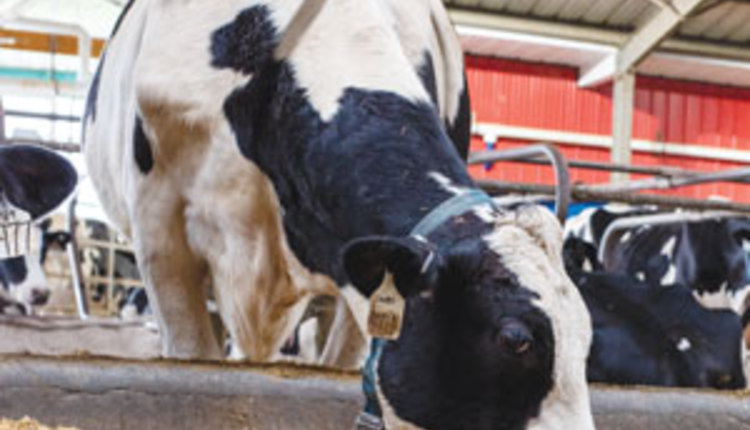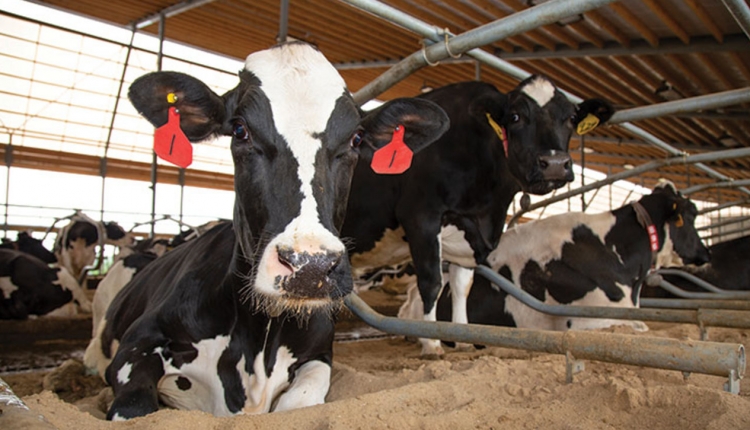
With the transition from pregnancy and the dry period to lactation after calving, dairy cows face significant physiological and metabolic changes. Maladaptation to those changes may lead to cows succumbing to various postpartum health disorders, including those that are infectious or metabolic, at various degrees of severity, including clinical and subclinical manifestations.
In field studies of commercial farms, the estimated prevalence of dairy cows developing one or more health disorders in early lactation has ranged from 25% to 40%. Those rates are not only a concern from a welfare standpoint, but they come at a significant economic loss to dairy farmers. In our research and that of others, it has been demonstrated that the experience of postpartum health disorders, particularly when they are clinical and compounded on each other, results in not only treatment costs, but also longer term reductions in milk production and reproductive success. This leads to a greater risk of being culled and not making it to another lactation.
Different challenges
The risk factors for postpartum health disorders in dairy cows are varied, ranging from factors experienced in the prepartum to the early lactation period. In cows that experience health issues, we commonly see evidence of inflammation, immune system activation and dysfunction, excessive negative energy balance, and indicators of stress.
While there is much debate and knowledge to be learned around the exact chain of events within these physiological responses, the reality is that we still need to contend with the resultant health disorders and identify ways to prevent them.
One of the common health disorders observed in early lactation dairy cows is hyperketonemia, often characterized by high levels of circulating blood ketones (or beta-hydroxybutyrate; BHB). Ketone production in the liver, from mobilized body fat, is considered a normal physiological adaptation to lactation. However, when energy output is highly disproportional relative to intake of energy, excess body fat mobilization occurs and ketone production skyrockets. In certain cases, cows may experience clinical signs, often labeled as ketosis; in absence of those signs, it is often labeled as subclinical ketosis.
Our research on hyperketonemia in the last number of years had been focused on cows milked in automated (robotic) milking systems (AMS). Some of our interest in this area came as a result of a study from our university where we demonstrated that the herd-level risk of hyperketonemia in early lactation was 1.5 times greater in mature cows in AMS herds compared to those in conventionally milked herds. While we did not explore risk factors in that study, one of the hypotheses was that greater milking frequency and milk yield in early lactation for the AMS cows might have contributed to this finding. This idea would fit with some of the current thinking around hyperketonemia, which dictates that in situations of high milk production, we may see elevated circulating ketones. This is not necessarily always problematic as long as there are no other associated pathological conditions.
Cause or effect?
In a recent study, we were able to characterize the prevalence of hyperketonemia on a large sample of AMS farms (n=162) across Canada using milk BHB levels from DHI sampling of fresh cows. Hyperketonemia was defined as milk BHB of at least 0.15 millimoles per liter (mmol/L). While the overall prevalence of hyperketonemia (22% in all cows, 27% in multiparous cows) was similar to other studies of conventionally milked cows, we did detect a negative association between milk yield and its prevalence; specifically, herds with higher hyperketonemia prevalence had lower average milk yield in early lactation.
This would suggest that the elevation of ketone levels that may be observed in AMS herds is not simply symptomatic of greater milk yield in those herds. Rather, high BHB in those AMS herds may actually be leading to reductions in production. Now, the risk factors for excessive negative energy balance and ketone production in these cows are likely varied, and potentially similar to that in conventional herds (for example, overconditioning or poor dry matter intake). However, there may also be some AMS-specific risk factors.
In another one of our AMS studies, cows diagnosed with hyperketonemia, based on blood BHB, had fewer milkings per day in the days prior to diagnosis. It is possible that low milking frequency in fresh cows may raise the risk and persistence of hyperketonemia. This highlights the importance of proper training and AMS settings to encourage frequent AMS visits, particularly in early lactation. Interestingly, also in that study, cows with hyperketonemia produced more milk relative to the amount of feed provided at the AMS, indicating that insufficient energy supplementation could contribute to this metabolic challenge.
While we expect the dry matter intake of fresh cows to rise quickly in early lactation, including intake of both the partial mixed ration (PMR) and AMS concentrate, we are often hesitant to raise the rate of AMS supplementation too quickly. One reason is that concentrate, which may be higher in starch, may have negative ruminal effects (acidosis) if increased too quickly.
More energy benefits
One alternative strategy to this would be to elevate the energy supplementation to these cows through other energetic feed supplements like sugars and gluconeogenic precursors, which may be more rumen friendly. In an initial study in this area, we supplemented cows on commercial AMS dairy farms for the first 60 days in milk (DIM) with either just the AMS pellet or the AMS pellet plus additional molasses-based liquid feed.
The cows receiving the molasses had fewer repeat positive hyperketonemia tests (blood BHB of at least 1.2 mmol/L) and lower average blood BHB levels at approximately 15 DIM. Cows receiving the molasses were also able to maintain a more stable body condition score (BCS) as they tended to lose less condition across the first 60 DIM. Thus, this work provided some of the first evidence that we can bridge the energy gap in fresh cows milked in AMS through strategic supplementation.
In a more recent study, we used a similar experimental design, except this time, we supplemented cows through the AMS with a dry, pure glycerol product, which was incorporated directly into the AMS concentrate pellet. Glycerol is a gluconeogenic precursor and by-product of the biofuel industry. In previous research from our group and others, when pure glycerol is fed, either as a liquid or dry product, it has been demonstrated to have positive impacts on energy metabolism in transition cows.
The supplementation of dry, pure glycerol through the AMS concentrate for the first 21 DIM, as opposed to receiving the same amount of AMS concentrate without the glycerol, had positive impacts on indicators of energy metabolism and on the maintenance of BCS. Specifically, supplementation reduced the risk of elevated BHB in over-conditioned cows and also resulted in less BCS loss from calving to 63 DIM. Supplemented cows also had greater milking frequency, a tendency for higher milk yield during the 21-day supplementation period, and greater milking frequency and milk yield following supplementation from 22 to 150 DIM.
Overall, the results of these studies demonstrate that strategic supplementation of AMS cows in early lactation with alternative energy sources, including sugars and gluconeogenic precursors like glycerol, can be used to improve metabolic health of early lactation cows, minimize body condition loss, and promote greater milk production. Such nutritional strategies must be matched with other best practices to minimize stress and optimize dry matter intake. These efforts will help reduce the risk of excessive negative energy balance and other health disorders, thus promoting greater cow productivity and longevity.










